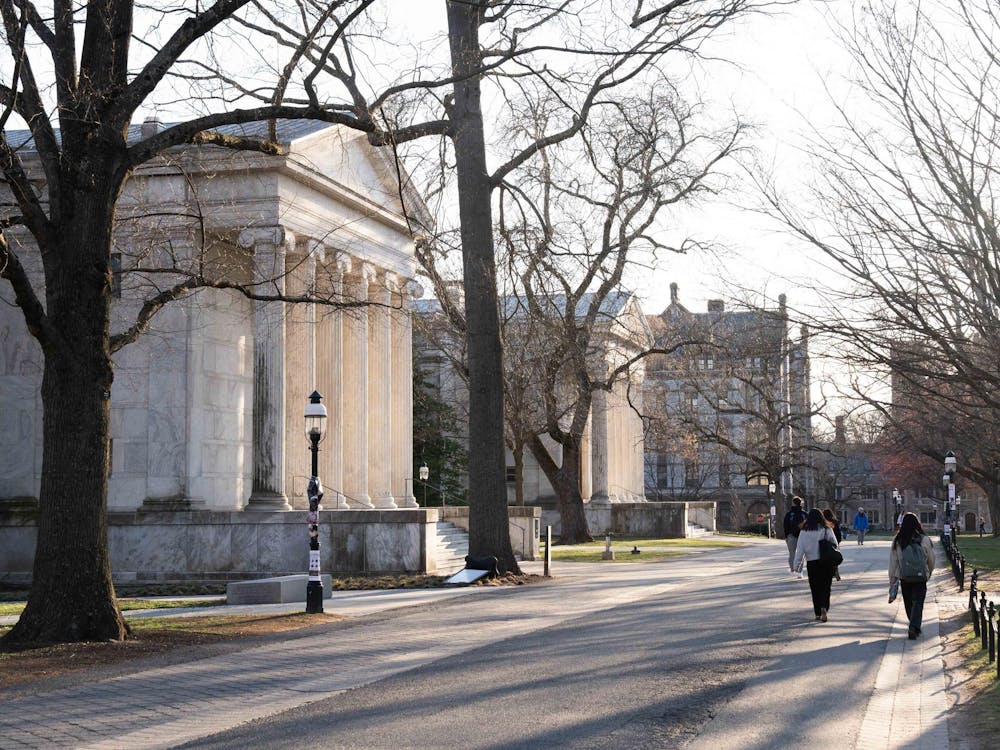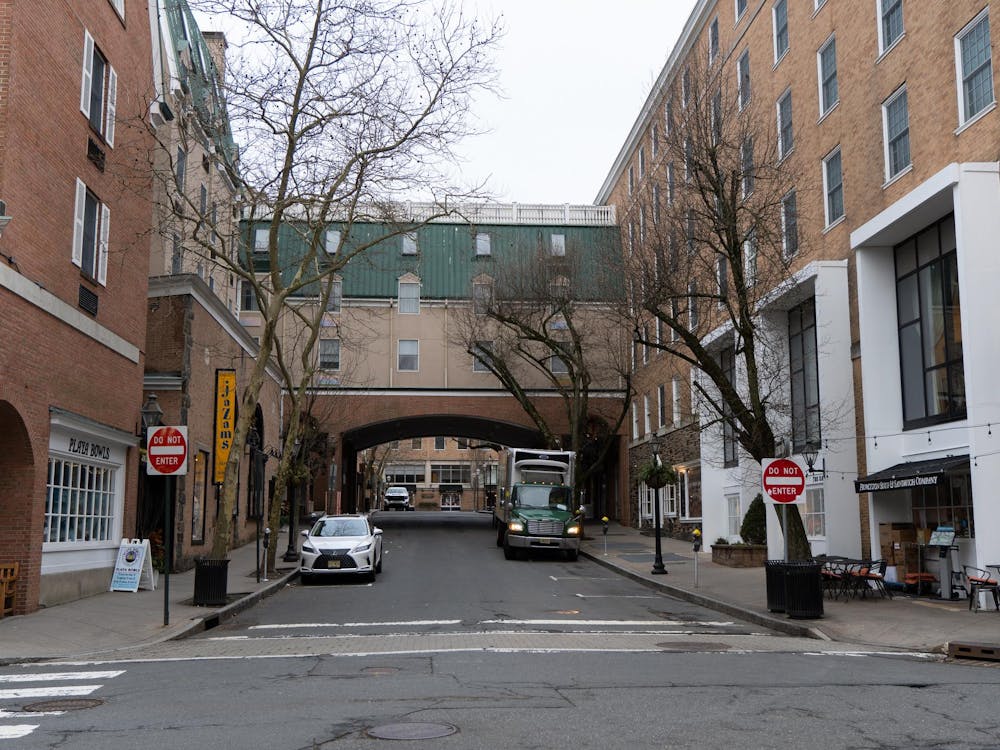The transformation of the former Dinky station’s location to a state-of-the-art performance center for the University is complete. The Lewis Center for the Arts, replete with 146,000 square feet of space for students in theater, dance, music, and the visual arts, will become a brand new arts hub.
“We want the new buildings and the neighborhood around them to become a place where the University and the town and others intersect together, and we expect that will be around artistic performance and around the open spaces that exist there,” said President Christopher Eisgruber ’83.
Designed by Steven Holl Architects, the Lewis Center is composed of three buildings: the Wallace Dance Building and Theater, the Arts Tower, and the Music Building.
Its opening celebration begins Thursday. The Festival of the Arts, which will take place Oct. 5–8, will cater to this spirit of collaboration between the arts. Several interdisciplinary performances will be featured, from a kinetic lighting installation accompanied by the Princeton Laptop Orchestra and other music groups, to a sculpture tour accompanied by Sō Percussion.
Featuring talented alumni, professionals from outside the University community, and current students, the festival will be a true showcase of the limitless creativity that the Lewis Center can help express.
“I think [the Festival will] also show people the different ways these spaces can be used,” architect Noah Yaffe said. Yaffe was one of two senior partners on the project.
The dance building includes a black-box steel theater which seats 150 people and other dance theaters within a concrete frame.
The cylindrical concrete and stone tower embedded in the Arts Tower, according to Steven Holl Architects, is a nod to Blair Arch, and the music building boasts a suspension of resonant wooden practice rooms on steel rods. The latter exhibits wonderful acoustics particularly suited to instrumental music.

The architects of the Lewis Center also incorporated a spacious underground area dubbed the ‘Forum,’ an 8,000 square-foot open space that connects all three buildings. Pressing the elevator button starred and marked with an “F’ takes visitors there. The Forum draws its light from vast skylights set into the floor of the reflecting pool in the plaza directly above it. The dancing light “brings a spirit of joy and creativity to that space that augments what the different departments are trying to do in their programs,” said Yaffe.
Yaffe explained that the spirit of collaboration pervades the underground common space, too. Similarly, sharing artistic ideas among the University’s departments will be easily bolstered in this synergistic space.
“In many ways, the Forum serves as a kind of social condenser that allows for maximum exchange between people,” Yaffe said.
The Center is an unmistakable manifestation of the University’s dedication to the arts on campus, according to President Eisgruber. It is a significant step for an institution where the arts have been gradually gaining ground for decades. The 22-acre Arts and Transit Neighborhood where the new Lewis Center is located includes the arts buildings and two restaurants, both of which are converted Dinky train stations.

Construction of the complex has been in progress for three and a half years. Its conception, however, came long before that. It was under President Emerita Shirley Tilghman’s leadership that the idea for the Lewis Center came about.
“The motivation for the Lewis Center really began with conversations that I had almost as soon as I was appointed president, even before I took off, with students in my own department, in molecular biology, who were involved in the arts,” Tilghman said. “They literally poured into my office to tell me how challenging it was to pursue music and dance at Princeton.”
Not long after that, Tilghman set up a committee of faculty, staff, and students to assess the University’s arts programs. After some analysis, the panel “made it clear that we needed to make a very significant investment in the performing and musical arts,” she said.
Princeton University Orchestra conductor and Director of the Program in Musical Performance Michael Pratt was a member of this panel. To him, the Lewis Center is a fulfilled promise. It is also “an extraordinary expression of the commitment that Princeton University, that the administration, that the trustees, feel towards artistic expression.”
“Ever since Shirley Tilghman announced this initiative more than a decade ago now, we’ve seen a continuing increase in the number and caliber of students coming in with very strong interests in the arts, and we’ve seen continued growth in student activity,” Eisgruber explained.
The creation of opportunities for students to engage in the arts has been a need at Princeton for decades now, according to administrators, students, and alumni.
Dan Teager ’83 recalled his own experiences with the arts on campus. As a trumpet player in the jazz band, he and his colleagues pursued their musical interests largely independent of the University. Indeed, Teager says his development as a musician was “in spite of Princeton,” rather than by means of it.
“To have more spaces on campus where people can do more things, and encourage them to make their own music ... I’m delighted to see it,” Teager said. He referred to the older spaces for performers and artists on campus, such as the Woolworth Center for Musical Studies and 185 Nassau Street, as inadequate for student needs, explaining that he wishes the complex had existed during his time as a student.
The Woolworth Center “served all the purposes that it needed, but it’s also getting old,” said Kristin Hauge ’18. “It’s also nice to have this new building now because there’s better rehearsal spaces, better practice rooms, better pianos, which a lot of people are excited about, including me.” Hauge also appreciated the extra recognition that the new Lewis Center for the Arts affords the music and other performing arts departments.
The University’s formal arts education development, as well as support for extracurricular activities in the arts, have taken another massive step forward with the opening of the new Lewis Center, as students gain space not only for the academic study of art, but also for its practical expression and implementation.
“There’s now going to be even more space for rehearsal and performance,” Eisgruber said. “I think this will support the students who are artists on the campus right now, and it will attract even more to the school. And I think it means opportunities both for those who have various serious commitments in the arts, and think of that as a very important part of what they do, and also other students who just want an experience with the arts while they’re here.”
Orchestral performers, dancers, and other artists on campus have already started to make use of the resonant wooden practice rooms and Steinway pianos populating the buildings of the Lewis Center, as well as its many other offerings.
“The true hero is Peter Lewis of the Class of 1955,” Tilghman noted, adding that Lewis was the “angel investor” who gave the financial contributions that made the Lewis Center possible.
Those planning to attend the upcoming Festival of the Arts can visit its website at lcaopening.princeton.edu for a detailed schedule of events, maps and parking information, and email updates.
“To have the campus alive with artistic expression brings light into everyone’s life,” Pratt said.







